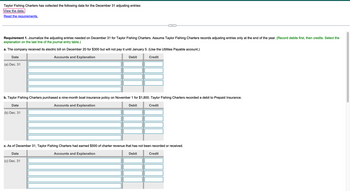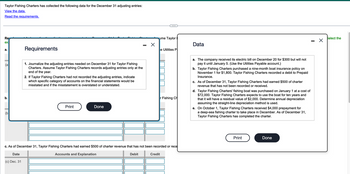
FINANCIAL ACCOUNTING
10th Edition
ISBN: 9781259964947
Author: Libby
Publisher: MCG
expand_more
expand_more
format_list_bulleted
Concept explainers
Topic Video
Question

Transcribed Image Text:Taylor Fishing Charters has collected the following data for the December 31 adjusting entries:
View the data.
Read the requirements.
Requirement 1. Journalize the adjusting entries needed on December 31 for Taylor Fishing Charters. Assume Taylor Fishing Charters records adjusting entries only at the end of the year. (Record debits first, then credits. Select the
explanation on the last line of the journal entry table.)
a. The company received its electric bill on December 20 for $300 but will not pay it until January 5. (Use the Utilities Payable account.)
Accounts and Explanation
Credit
Date
(a) Dec. 31
b. Taylor Fishing Charters purchased a nine-month boat insurance policy on November 1 for $1,800. Taylor Fishing Charters recorded a debit to Prepaid Insurance.
Accounts and Explanation
Debit
Date
Debit
(b) Dec. 31
Credit
c. As of December 31, Taylor Fishing Charters had earned $500 of charter revenue that has not been recorded or received.
Date
Accounts and Explanation
Debit
(c) Dec. 31
Credit

Transcribed Image Text:Taylor
Fishing Charters has collected the following data for the December 31 adjusting entries:
View the data.
Read the requirements.
Re
ex
a.
(a
b.
(b
Requirements
V
1. Journalize the adjusting entries needed on December 31 for Taylor Fishing
Charters. Assume Taylor Fishing Charters records adjusting entries only at the
end of the year.
2. If Taylor Fishing Charters had not recorded the adjusting entries, indicate
which specific category of accounts on the financial statements would be
misstated and if the misstatement is overstated or understated.
Print
Done
I
Debit
X
ume Taylor
e Utilities P
c. As of December 31, Taylor Fishing Charters had earned $500 of charter revenue that has not been recorded or rece
Date
Accounts and Explanation
(c) Dec. 31
Credit
r Fishing Ch
Data
a. The company received its electric bill on December 20 for $300 but will not
pay it until January 5. (Use the Utilities Payable account.)
b. Taylor Fishing Charters purchased a nine-month boat insurance policy on
November 1 for $1,800. Taylor Fishing Charters recorded a debit to Prepaid
Insurance.
c. As of December 31, Taylor Fishing Charters had earned $500 of charter
revenue that has not been recorded or received.
d. Taylor Fishing Charters' fishing boat was purchased on January 1 at a cost of
$72,000. Taylor Fishing Charters expects to use the boat for ten years and
that it will have a residual value of $2,000. Determine annual depreciation
assuming the straight-line depreciation method is used.
e. On October 1, Taylor Fishing Charters received $4,000 prepayment for
a deep-sea fishing charter to take place in December. As of December 31,
Taylor Fishing Charters has completed the charter.
Print
Done
-
X
Select the
Expert Solution
This question has been solved!
Explore an expertly crafted, step-by-step solution for a thorough understanding of key concepts.
Step by stepSolved in 4 steps

Knowledge Booster
Learn more about
Need a deep-dive on the concept behind this application? Look no further. Learn more about this topic, accounting and related others by exploring similar questions and additional content below.Similar questions
- On July 1, 2022, Sheridan Company pays $18,500 to Wildhorse Co. for a 2-year insurance contract. Both companies have fiscal years ending December 31. (a1) Journalize the entry on July 1 and the adjusting entry on December 31 for Wildhorse Co.. Wildhorse uses the accounts Unearned Service Revenue and Service Revenue. (Record journal entries in the order presented in the problem. If no entry is required, select "No Entry" for the account titles and enter 0 for the amounts. Credit account titles are automatically indented when the amount is entered. Do not indent manually.) Date Account Titles and Explanation Debit Creditarrow_forwardI. The senior accountant for Koo Graphics discovered that the company'e accounting clerk had a different method of recording the purchase cf automobile insurance. Specifically, when one-year policies were purchased on July 1, the clerk debited Insurance Expense $7200 and credited Bank $7200, A. Has the clerk done anything seriously wrong? Explain. B. Use the T-accounts in your Workbook to calculate the year-end adjustment for insurance for December 31. Journalize the adjusting entry.arrow_forwardNote:- Do not provide handwritten solution. Maintain accuracy and quality in your answer. Take care of plagiarism. Answer completely. You will get up vote for sure.arrow_forward
- Please help with a and barrow_forwardThe Yellow Company made year-end adjusting entries affecting each of the following accounts: Office Salaries Payable (credited); Depreciation Expense (debited); Unearned Rental Revenue (debited); and Prepaid Insurance (credited). Which account is likely to appear in Yellow's reversing entries? a. Office salaries payable b. Depreciation expense c. Unearned rental revenue d. Prepaid insurancearrow_forward1. What is the net overstatement/(understatement) of KnK for the year ended December31, 2022? 2. What adjusting entry is necessary to correct KnK’s financial statements for the yearended Dec 31, 2022 ?arrow_forward
- The Yellow Canoe Company made year-end adjusting entries affecting each of the following accounts: InterestRevenue (credited); Depreciation Expense (debited); Unearned Rental Revenue (debited); and Prepaid Insurance(credited). Which account is likely to appear in Yellow Canoe’s reversing entries?a. Depreciation Expenseb. Interest Revenuec. Prepaid Insuranced. None of these answer choices is correct.arrow_forwardThe information necessary for preparing the 2021 year-end adjusting entries for Gamecock Advertising Agency appears below. Gamecock’s fiscal year-end is December 31. 1. On July 1, 2021, Gamecock receives $6,000 from a customer for advertising services to be given evenly over the next 10 months. Gamecock credits Deferred Revenue. 2. At the beginning of the year, Gamecock’s depreciable equipment has a cost of $28,000, a four-year life, and no salvage value. The equipment is depreciated evenly (straight-line depreciation method) over the four years. 3. On May 1, 2021, the company pays $4,800 for a two-year fire and liability insurance policy and debits Prepaid Insurance. 4. On September 1, 2021, the company borrows $20,000 from a local bank and signs a note. Principal and interest at 12% will be paid on August 31, 2022. 5. At year-end there is a $2,700 debit balance in the Supplies (asset) account. Only $1,000 of supplies remains on hand.Required: Record the necessary adjusting entries on…arrow_forwardAmong other things, the trial balance of Ashanti, Inc., at December 31, 2023 includesPrepaid Insurance of $7,500. Examination of the company’s records shows that an adjustment should be made to the Prepaid Insurance account for the following reason: of the $7,500 of Prepaid Insurance in the trial balance, $2,500 is for insurance coverage during the months after December 31, 2023. Which of the following is the correct adjusting entry? Debit Prepaid Insurance $7,500; credit Insurance Expense $7,500. Debit Prepaid Insurance $2,500; credit Insurance Expense $2,500. Debit Prepaid Insurance $5,000; credit Insurance Expense $5,000. Debit Insurance Expense $5,000; credit Prepaid Insurance $5,000. Debit Insurance Expense $2,500; credit Prepaid Insurance $2,500. Debit Insurance Expense $7,500; credit Prepaid Insurance $7,500.arrow_forward
arrow_back_ios
arrow_forward_ios
Recommended textbooks for you

 AccountingAccountingISBN:9781337272094Author:WARREN, Carl S., Reeve, James M., Duchac, Jonathan E.Publisher:Cengage Learning,
AccountingAccountingISBN:9781337272094Author:WARREN, Carl S., Reeve, James M., Duchac, Jonathan E.Publisher:Cengage Learning, Accounting Information SystemsAccountingISBN:9781337619202Author:Hall, James A.Publisher:Cengage Learning,
Accounting Information SystemsAccountingISBN:9781337619202Author:Hall, James A.Publisher:Cengage Learning, Horngren's Cost Accounting: A Managerial Emphasis...AccountingISBN:9780134475585Author:Srikant M. Datar, Madhav V. RajanPublisher:PEARSON
Horngren's Cost Accounting: A Managerial Emphasis...AccountingISBN:9780134475585Author:Srikant M. Datar, Madhav V. RajanPublisher:PEARSON Intermediate AccountingAccountingISBN:9781259722660Author:J. David Spiceland, Mark W. Nelson, Wayne M ThomasPublisher:McGraw-Hill Education
Intermediate AccountingAccountingISBN:9781259722660Author:J. David Spiceland, Mark W. Nelson, Wayne M ThomasPublisher:McGraw-Hill Education Financial and Managerial AccountingAccountingISBN:9781259726705Author:John J Wild, Ken W. Shaw, Barbara Chiappetta Fundamental Accounting PrinciplesPublisher:McGraw-Hill Education
Financial and Managerial AccountingAccountingISBN:9781259726705Author:John J Wild, Ken W. Shaw, Barbara Chiappetta Fundamental Accounting PrinciplesPublisher:McGraw-Hill Education


Accounting
Accounting
ISBN:9781337272094
Author:WARREN, Carl S., Reeve, James M., Duchac, Jonathan E.
Publisher:Cengage Learning,

Accounting Information Systems
Accounting
ISBN:9781337619202
Author:Hall, James A.
Publisher:Cengage Learning,

Horngren's Cost Accounting: A Managerial Emphasis...
Accounting
ISBN:9780134475585
Author:Srikant M. Datar, Madhav V. Rajan
Publisher:PEARSON

Intermediate Accounting
Accounting
ISBN:9781259722660
Author:J. David Spiceland, Mark W. Nelson, Wayne M Thomas
Publisher:McGraw-Hill Education

Financial and Managerial Accounting
Accounting
ISBN:9781259726705
Author:John J Wild, Ken W. Shaw, Barbara Chiappetta Fundamental Accounting Principles
Publisher:McGraw-Hill Education